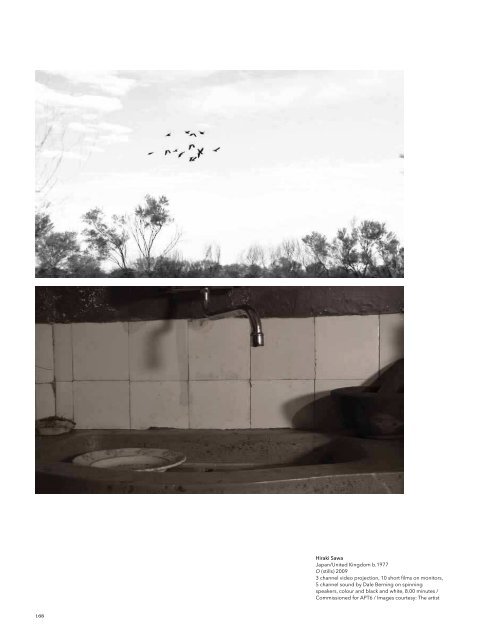Queensland Art Gallery - Queensland Government
Queensland Art Gallery - Queensland Government
Queensland Art Gallery - Queensland Government
Create successful ePaper yourself
Turn your PDF publications into a flip-book with our unique Google optimized e-Paper software.
Hiraki Sawa<br />
Active stillness<br />
Hiraki Sawa’s video animations are eloquent reflections on ideas of<br />
time and motion, home and place. Having lived in both London and<br />
Kanazawa for many years, the themes of travel, mobility and distance<br />
are important references for Sawa, and his works transport ordinary<br />
objects into the realms of the subconscious and the surreal. Recurrent<br />
motifs include aircraft, Ferris wheels and rocking horses, which trace<br />
journeys ‘from one place to another, and back again’. 1<br />
Sawa’s recent works are immersive, spatial installations of image and<br />
sound which explore concepts of abstract motion or ‘active stillness’. 2<br />
Hako 2006 is a six-channel work tracing changes in the landscape<br />
through the imagery of a nuclear power station, model domestic<br />
interiors, and an ancient Shinto shrine that is rebuilt every 20 years. 3<br />
Out of the blue 2009 is a two-channel video installation. One is a<br />
sequential narrative of shadows cast by isolated objects in a domestic<br />
space, the other is a single continuous shot of people walking languidly<br />
up and down a steep sand dune, its measured tracking shots in slow<br />
motion highlighting the physical and perceptual interactions that occur<br />
in one’s passage through a particular terrain.<br />
as a whole and the minute and intricate details, where countless<br />
patterns are revealed.<br />
Complementing the vast, unpeopled spaces of the desert are scenes<br />
of the dusty interiors of an abandoned house:<br />
There is a home in the mountains near the river near the sea. It is tall<br />
and it is old and its floors are of cracked, red clay. It is full of things in<br />
piles and heaps and layers, yet empty of both absence and presence.<br />
It has known too many people and framed too many lives to be<br />
missing only one of these. 6<br />
This focus on a neglected domestic space, once occupied and lively,<br />
reflects on the cycles of life, and is augmented by an enchanting<br />
exploration of the surface of the moon as it orbits the earth. Sawa’s ten<br />
short films in O 2009 feature individual objects — a glass bottle, a brass<br />
bell, a china bowl — which endlessly spin; an action which contradicts<br />
their purpose. The china bowl jerkily rotating on its base, for example,<br />
is an incongruous and comical inversion of its function.<br />
Commissioned for APT6, O 2009 is a multi-channel installation<br />
featuring a soundtrack by London-based composer Dale Berning.<br />
It builds on the artist’s interest in journeys and cycles, while also<br />
considering expression as a continuous flow, using the circle as a<br />
poignant visual metaphor. The work is comprised of ten short films of<br />
spinning objects, as well as a three-channel projection which traverses<br />
the moon’s surface, the empty interiors of an abandoned house, and<br />
the vast expanses of the Central Australian desert, which Sawa visited<br />
in April 2009. Tracing a circuit starting and ending in Alice Springs,<br />
Sawa travelled between the rust red ranges and the bleached spinifex<br />
terrain of the desert landscape:<br />
Hiraki Sawa’s emphasis on action over narrative creates an absorbing<br />
and compelling study of momentum and balance, continuity and<br />
repetition. The soundtrack reinforces the non-linearity of his<br />
approach. It is a composition of spinning sounds and silences<br />
played on rotating speakers. As Sawa says, ‘Coming full circle is<br />
movement without displacement. In that time, you simply are, and<br />
all change is in the looking’. 7<br />
Mellissa Kavenagh<br />
Hiraki Sawa<br />
Japan/United Kingdom b.1977<br />
O (stills) 2009<br />
3 channel video projection, 10 short films on monitors,<br />
5 channel sound by Dale Berning on spinning<br />
speakers, colour and black and white, 8.00 minutes /<br />
Commissioned for APT6 / Images courtesy: The artist<br />
A round trip takes you on the same route twice but in opposite<br />
directions. You end up where you began, and in between nothing<br />
takes place. You drive up a road and see the world on either side as<br />
it is. Driving back down again covers the same ground, the world<br />
on either side does not move or change, yet seen from behind,<br />
everything is different. I am interested in this active stillness . . . 4<br />
Towards the end of his journey, Sawa encountered the ancient<br />
meteorite crater of Tnorala (Gosse Bluff), a place of cultural<br />
significance to the Western Arrernte people, as well as a site of<br />
international scientific interest. 5 The projection depicts a bird circling<br />
low over the seabed, as a tugboat travels across the frame against a<br />
background of spinning wind turbines. The crater is depicted from<br />
above, revealing the mounds and cracks in the rock walls. Inherent in<br />
this sequence is the artist’s focus on the elemental: the wind, the sea<br />
and the earth, all moving in an unbroken flow. Images of swaying grass<br />
and rippling clouds shift the viewer’s focus between the composition<br />
Endnotes<br />
1 Hiraki Sawa, artist statement in an email to the author, 18 September 2009.<br />
2 Sawa, artist statement.<br />
3 The Shinto shrine in Ise, Japan, is completely reconstructed every 20 years as part<br />
of the Shinto belief in the cycle of renewal in nature; it is also a way of passing<br />
building techniques from one generation to the next.<br />
4 Sawa, artist statement.<br />
5 Tnorala (Gosse Bluff) is an ancient site over 142 million years old, and is located<br />
175 kilometres west of Alice Springs. According to both Aboriginal culture and<br />
scientific interpretation, the site is celestial in origin.<br />
6 Sawa, artist statement.<br />
7 Sawa, artist statement.<br />
168 169
















